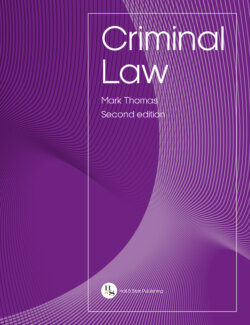Читать книгу Criminal Law - Mark Thomas - Страница 57
На сайте Литреса книга снята с продажи.
2.1.1Finding the actus reus
ОглавлениеWe find the actus reus and know what the actus reus of an offence is by observing the common law and statute.
Table 2.1Finding the actus reus
| Example of offence | Type of offence | Where can the actus reus be found? |
| Murder | Common law | The definition long cited is that of Sir Edward Coke CJ who defined murder as the ‘unlawful killing of a human being under the Queen’s peace with malice aforethought, express or implied’. The actus reus in that definition includes: •unlawful killing; •of a human being; •under the Queen’s peace. |
| Theft | Statutory | The definition is provided in s 1 of the Theft Act 1968 as the dishonest appropriation of property belonging to another with the intention of permanently depriving the other of it. The actus reus in that definition includes •appropriation; •of property; •belonging to another. |
There are, of course, certain offences that do not fall neatly into these categories. Take, for example, the offence of common assault.
According to DPP v Taylor; DPP v Little [1992] QB 645, common assault is a ‘statutory offence’. This means that when charged with an offence, the defendant would be charged ‘contrary’ to s 39 of the Criminal Justice Act (CJA) 1988. However, s 39 does not provide a definition of assault; rather it simply provides:
Common assault and battery shall be summary offences and a person guilty of either of them shall be liable to a fine not exceeding level 5 on the standard scale, to imprisonment for a term not exceeding six months, or to both.
One must therefore turn to the common law to find the actus reus of an assault. According to Goff LJ in Collins v Wilcock [1984] 3 All ER 374, common assault can be defined as ‘an act which causes another person to apprehend the infliction of immediate, unlawful force on his person’. The actus reus of common assault is therefore:
•an act;
•which causes another to;
•apprehend the infliction of immediate, unlawful force.
We shall consider each of these offences separately in the forthcoming chapters; however, it remains helpful to use these offences as examples. It is essential that you understand where we find the actus reus of a certain offence, and this will be detailed clearly in Parts II and III of this text.
